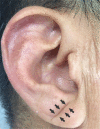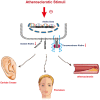Patients with Earlobe Crease May Associate with Lower Concentration of the Age-Suppressing Hormone Klotho
- PMID: 34858047
- PMCID: PMC8629917
- DOI: 10.2147/IJGM.S300309
Patients with Earlobe Crease May Associate with Lower Concentration of the Age-Suppressing Hormone Klotho
Abstract
Objective: Earlobe crease (ELC) has been considered as a skin sign of atherosclerosis, and its pathophysiological mechanism is still unclear. Our study aims to test the hypothesis that ELC patients with lower serum levels of the age-suppressing hormone Klotho, which is not only associated with premature aging but also with endothelial dysfunction, may be associated with atherosclerosis.
Methods: A total of 135 patients aged 40-68 years underwent coronary angiography. According to the presence or absence of coronary heart disease (CAD) and ELC, they were divided into three groups: CAD group and ELC group (ELC group, n = 45); no ELC group (non-ELC group, n = 45). There was no ELC or CAD in the control group (control group, n = 45). Serum Klotho concentration was obtained by enzyme-linked immunosorbent assay (ELISA).
Results: The Klotho level in the ELC group was 365.6 ± 38.1 pg/mL, while the Klotho level in the non-ELC group was 568.8 ± 44.9 pg/mL. It is worth noting that the Klotho level of the ELC group was significantly lower than that of the non-ELC group (P < 0.001). The serum Klotho level of the control group was higher than that of the non-ELC group (593.3±45.3 vs 568.8±44.9 pg/mL, P = 0.702), but the difference was not statistically significant. Multiple logistic regression analysis showed that the Klotho level is a parameter that affects the appearance of ELC.
Conclusion: Serum Klotho levels were considerably lower in patients with ELC. We concluded that the perturbations of Klotho in patients might be associated with ELC and with CAD.
Keywords: Klotho; atherosclerosis; earlobe crease; premature aging.
© 2021 Wang et al.
Conflict of interest statement
All authors declare no conflict of interest.
Figures
Similar articles
-
Adropin and Irisin Deficiencies Are Associated With Presence of Diagonal Earlobe Crease in CAD Patients.Front Cardiovasc Med. 2021 Oct 12;8:719763. doi: 10.3389/fcvm.2021.719763. eCollection 2021. Front Cardiovasc Med. 2021. PMID: 34712706 Free PMC article.
-
Earlobe Creases as a Marker of the Risk for Coronary Atherosclerosis Before Angiography in Elderly and Non-elderly Patients.Cureus. 2023 Mar 23;15(3):e36609. doi: 10.7759/cureus.36609. eCollection 2023 Mar. Cureus. 2023. PMID: 37101991 Free PMC article.
-
Bilateral diagonal earlobe crease and coronary artery disease: a significant association.Dermatology. 2004;209(4):271-5. doi: 10.1159/000080847. Dermatology. 2004. PMID: 15539887
-
Relation of the Bilateral Earlobe Crease to Endothelial Dysfunction.Am J Cardiol. 2017 Jun 15;119(12):1983-1988. doi: 10.1016/j.amjcard.2017.03.029. Epub 2017 Mar 29. Am J Cardiol. 2017. PMID: 28438303
-
[The diagonal ear lobe crease for evaluating coronary risk].Z Kardiol. 1995 Jul;84(7):512-9. Z Kardiol. 1995. PMID: 7676721 Review. German.
Cited by
-
Traditional Cardiovascular Risk Factors Associated with Diagonal Earlobe Crease (Frank Sign) in Mexican Adults: Aging, Obesity, Arterial Hypertension, and Being Male Are the Most Important.Int J Hypertens. 2024 Jun 21;2024:5598134. doi: 10.1155/2024/5598134. eCollection 2024. Int J Hypertens. 2024. PMID: 38948003 Free PMC article.
References
-
- Frank ST. Aural sign of coronary-artery disease. N Engl J Med. 1973;289(6):327–328. - PubMed
LinkOut - more resources
Full Text Sources
Miscellaneous




